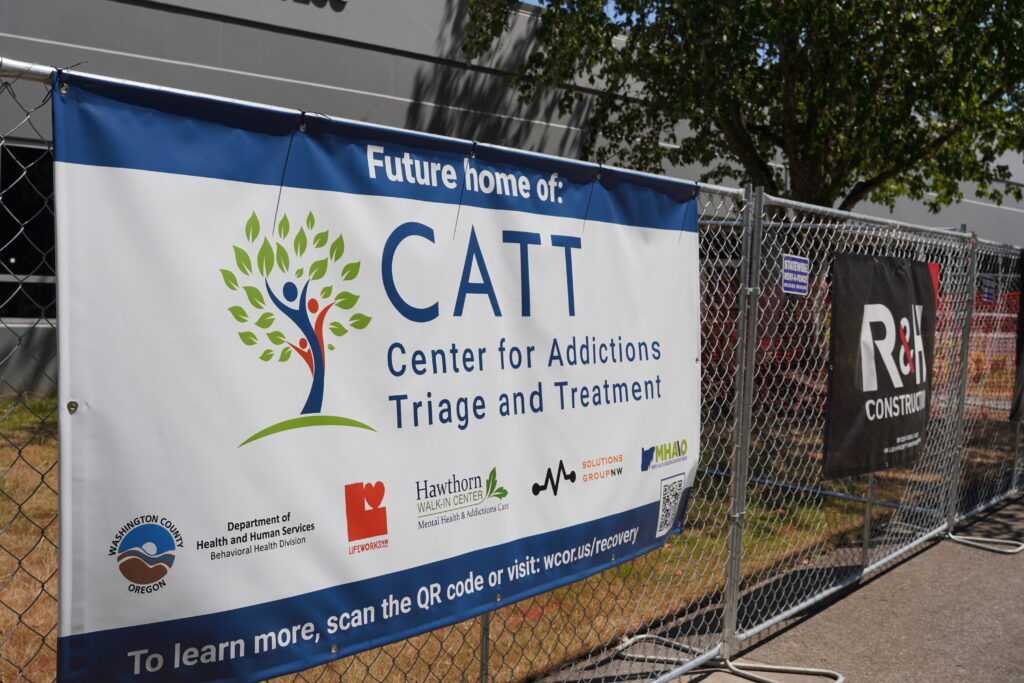
The site of Washington County’s planned Center for Addictions Triage and Treatment in HIllsboro. The center, when finished, will aid the county’s new programs that offer treatment instead of jail to people in addiction. (Ben Botkin/Oregon Capital Chronicle)
Washington and Clackamas counties on Tuesday filed a lawsuit against the Oregon Health Authority to overturn the agency’s formula for distributing more than $400 million in funding for drug addiction treatment and recovery services.
The two Portland-area counties’ filed a petition with the Oregon Court of Appeals that asks a judge to review the health authority’s process for determining how to allocate Measure 110 funding to different regions of Oregon. In 2020, voters passed Measure 110, which decriminalized possession of small amounts of drugs and put a share of cannabis revenue toward recovery and treatment, including harm reduction, peer mentor services and housing.
The health authority approved a new grant distribution formula to start in July 2025, and the counties say they were excluded from that process. They raised concerns before filing the lawsuit: In a July email, Washington County officials told the authority they could lose up to $32 million.
The suit seeks a judicial determination that the formula is invalid because it did not comply with the state law. Such a determination could force the authority and its Oversight and Accountability Council that allocates funding to rework the formula for the next round of money.
The money is designated to regions – from urban Portland to rural eastern Oregon – to fight a wave of fentanyl overdoses and other drug addictions. This year, Oregon lawmakers passed House Bill 4002, which created a new misdemeanor penalty for drug possession in September, but kept Measure 110 funding intact.
It also allocated separate grants for county deflection programs to steer people toward treatment and other recovery services and relies upon the Measure 110 funding formula. As a result, county officials allege the new Measure 110 formula has regional inequities and they worry those will become part of future funding shortages for deflection work.
The lawsuit emerged after counties received their first allocation of deflection grants from the state. It’s unclear what, if any, impact a ruling would have on the state funding for deflection programs, which more than two dozen Oregon counties, including Clackamas and Washington, have started or will do so.
Tim Heider, a spokesperson for the Oregon Health Authority, would not comment on the lawsuit.
The lawsuit does not directly seek more money for either county – or identify an amount that officials believe is equitable. But a ruling in their favor could lead to that.
Instead, Washington and Clackamas county officials allege in the petition that the health authority’s rulemaking process that determines how much money goes to each region did not provide the required public notices or hold hearings and offer opportunities for comment.
The funding formula is based on factors like population, overdoses and homeless counts. County officials say the regional allocations are inequitable.
Both counties put out a joint press release to announce the filing, but neither one made any officials available to answer questions.
‘Not received enough funding’
Washington County District Attorney Kevin Barton said the existing formula for deflection programs does not provide Oregon’s second-largest county as much as it needs, and it is not proportionate to what Multnomah County received for deflection.
Washington County qualified for $1.34 million for its program, while Multnomah County received nearly $4 million. That doesn’t include related services like Multnomah County’s center for police to drop people off for assessments.
Barton said Washington County’s share is not proportionate when looking at the populations. Washington County has about 600,000 people while Multnomah County has about 800,000 people.
“Washington County has not received enough funding to do the critical work that it needs to do for deflection,” Barton said in an interview.
As a result, Washington County’s work with police and outreach workers who go out on calls to help drug users is selective and focuses primarily on high-population areas, he said.
“One of the persistent challenges is the lack of sufficient resources and funding to contract with the treatment providers and to have the personnel to do the work that we know needs to be done,” said Barton, who is not involved in the county’s lawsuit.
He said he’s concerned about what would happen if funding were lowered. In a perfect world, he said, access to outreach workers would be the same throughout the county.
“The sheer logistics of the funding we have and the people we have hasn’t allowed for that to occur quite yet,” he said. “And if we lose funding, then I worry that some of those disparities could be exacerbated and we want to avoid that.”
Months-long concerns
The petition and exhibits show officials from both counties pressed the health authority’s council to reconsider its approach before they went to court.
On July 1, Zakir Khan, Washington County’s government relations manager, emailed health authority officials, asking they “slow down” the process of changing the Measure 110 funding formula.
“Counties have not been given a meaningful opportunity to engage in the process of giving feedback,” Khan wrote. “During the session, I was told that the conversation about amending the funding formula was taking place next year rather than now when I inquired about this. Adequate notice would’ve allowed for appropriate time to suggest alternative variables.”
His letter said Washington County stood to potentially lose as much as $32 million under the new funding formula, leading to “huge consequences.”
Clackamas County also asked the authority’s oversight council to reconsider its formula in an Aug. 8 letter. At the time, county board chair Tootie Smith told state officials the formula put Clackamas seventh on the list for funding, meaning smaller counties would get more money.
“Clackamas bears responsibility for serving its own residents and also is expected – and frequently asked – by our regional partners to shoulder additional work so no single county in the metro area bears the addiction services burden in isolation,” the letter said. “Clackamas County shares a long border and transportation, social, and economic connections with Multnomah County.”
The letter suggests Clackamas was ranked low in terms of funding priority because the formula overly relies upon an annual homeless population count and “penalizes” the county for its success with housing programs.
And with that formula determining deflection funding, the letter said, concerns are even higher.
SUBSCRIBE: GET THE MORNING HEADLINES DELIVERED TO YOUR INBOX
EMEA Tribune is not involved in this news article, it is taken from our partners and or from the News Agencies. Copyright and Credit go to the News Agencies, email news@emeatribune.com Follow our WhatsApp verified Channel




